This article was co-authored by Jonathan Frank, MD. Dr. Jonathan Frank is an Orthopedic Surgeon based in Beverly Hills, California, specializing in sports medicine and joint preservation. Dr. Frank's practice focuses on minimally invasive, arthroscopic surgery of the knee, shoulder, hip, and elbow. Dr. Frank holds an MD from the University of California, Los Angeles School of Medicine. He completed an orthopedic residency at Rush University Medical Center in Chicago and a fellowship in Orthopedic Sports Medicine and Hip Preservation at the Steadman Clinic in Vail, Colorado. He is a staff team physician for the US Ski and Snowboard Team. Dr. Frank is currently a scientific reviewer for top peer-reviewed scientific journals, and his research has been presented at regional, national, and international orthopedic conferences, winning several awards including the prestigious Mark Coventry and William A Grana awards.
There are 14 references cited in this article, which can be found at the bottom of the page.
This article has been viewed 26,277 times.
Elbow inflammation, also called tendinitis or "tennis elbow," can make your daily life difficult, but there are many options for treating it. Resting and elevating your arm and icing your elbow are the best ways to treat elbow inflammation. Anti-inflammatory pain relievers can also be helpful. Contact your doctor if the elbow inflammation persists more than a few days or gets worse by the day. They can diagnose the cause of the swelling and recommend more intensive treatments to help you recover as soon as possible.
Steps
Easing the Swelling
-
1Elevate your arm to reduce the swelling. Aim to keep your arm elevated throughout the day. Prop your arm up on a cushion when sitting at a desk or table, particularly if you will be there for a long period of time. You should also prop it up when you are relaxing to help minimize the swelling.[1]
- Ideally, your elbow should be raised above the level of your heart.[2]
-
2Ice your elbow 3-4 times a day. Wrap an ice pack in a cloth and apply it to your elbow. Hold it in place for 15-20 minutes to help reduce the swelling. Do this 3-4 times throughout the day until the swelling subsides.[3]
- The cold from an ice pack can damage your skin if it is applied directly onto it without a cloth barrier.
Advertisement -
3Wrap a compression bandage around your elbow. Compressing the swollen area around your elbow will help to reduce inflammation. Wrap an elastic bandage or compression wrap around the affected area and secure it with a safety pin or medical tape. Remove the wrap if your arm begins to feel numb or sore.[4]
- A compression wrap can be worn for several days until the swelling subsides.
- Compression bandages can be purchased from your local pharmacy. You can either purchase it as a wrap or as a “sock” that slides onto your arm over your hand.
- Wrap the bandage from the bottom of your elbow towards the top, so you move the fluid towards your heart.[5]
-
4Take ibuprofen or naproxen to reduce swelling. Over-the-counter anti-inflammatory medications will help to reduce your elbow inflammation. Take either ibuprofen or naproxen as recommended by your doctor until the swelling subsides. Do not exceed the dose recommended on the bottle or by your doctor or pharmacist.[6]
- Note that acetaminophen will help ease the pain of an injured elbow but will not reduce the swelling.
-
5Apply a topical NSAID 4 times a day as an alternative to oral pain relievers. Anti-inflammatory skin creams and gels can be effective in treating mild pain and inflammation. Apply a topical NSAID (nonsteroidal anti-inflammatory drug) directly to your elbow and massage it into your skin gently. For the best results, do this 4 times throughout the day.[7]
- Some topical NSAIDs can be purchased over-the-counter at your local pharmacy, while others require a prescription from your doctor.
- Topical NSAIDs should not be used to treat inflammation due to a fracture or torn tendon.
- Do not use topical NSAIDs if you have a history of ulcers or gastrointestinal bleeding since it is absorbed through the skin into the bloodstream.[8]
- Discontinue using topical NSAIDs if you experience redness, irritation, stomach or esophageal pain, or rash.
-
6Avoid strenuous activities that involve the affected arm. While you are suffering from elbow inflammation, it is important to rest your arm.[9] Avoid doing any activities that will strain the affected muscles and tendons. This could include heavy lifting, strength-building exercises, household chores, assembly work, or other intensive activities.[10]
- If you regularly carry out strenuous manual tasks at work, ask your employer if you can modify activities that may aggravate your elbow inflammation.
- You should also avoid leaning on your arm.
Seeking Medical Attention
-
1Contact your doctor if the swelling does not improve after several days. If you can't reduce your elbow inflammation at home, you may require a more intensive treatment. Contact your doctor if the swelling or pain in your elbow increases quickly, or if there is no change in the swelling after several days. Your elbow inflammation may be due to a serious injury such as a sprain or broken bone.[11]
- Your doctor can diagnose whether your elbow inflammation is due to a one-time injury, wear and tear, or a disease like arthritis.[12]
- Your doctor may perform blood tests or an ultrasound scan or X-ray to determine the cause of your elbow inflammation.[13]
- Swelling may also be due to an infection, which your doctor will likely prescribe antibiotics for.
-
2Ask your doctor about physiotherapy or physical therapy to treat persistent inflammation. A physiotherapist may use massage or other manual therapy techniques to treat your elbow inflammation while physical therapy will be more exercise-based. They can also teach you arm exercises to encourage blood flow to the area, relieve stiffness, and strengthen your muscles. Ask your doctor if physiotherapy is a good treatment option for you.[14]
- Your doctor can refer you to a physiotherapist in your area.
- Do not attempt rehabilitation exercises for your elbow without the recommendation of your doctor or physiotherapist.
-
3Inquire about steroid injections for short-term relief. Steroid injections can be given directly to the affected area of your elbow to reduce the swelling and treat pain. Ask your doctor if this treatment option would be right for you. The results of this treatment are short-term, but the procedure can be performed up to 3 times in 3-6 month intervals.[15]
- Your doctor may give you a local anesthetic before the procedure to numb the area.
-
4Make sure there is no fluid buildup in your arm. Ask your doctor if your elbow inflammation may be due to an excess of fluid around the affected area. If so, they may opt to drain the fluid with a needle and syringe. This should remove pressure and reduce swelling around your elbow.[16]
- After the procedure, you should wear a compression bandage to prevent fluid from building up again.
-
5Discuss surgery as a last option if you have had elbow inflammation for 6-12 months. Your doctor may recommend surgery if you have tried non-invasive treatment methods for more than 6 months without results. Ask your doctor if removing damaged tissue in your arm could improve your condition. Discuss the various surgical options you may have, and what your recovery would entail.[17]
- Rehabilitation exercises are a crucial part of recovery from elbow surgery.[18]
- Surgery may involve one large incision or several small incisions, depending on your specific injury.
- Your doctor may recommend that you wear an elbow brace for several weeks while your arm heals from surgery.
Expert Q&A
-
QuestionWhat causes inflammation of the elbow joint?
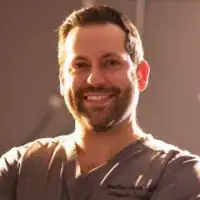 Jonathan Frank, MDDr. Jonathan Frank is an Orthopedic Surgeon based in Beverly Hills, California, specializing in sports medicine and joint preservation. Dr. Frank's practice focuses on minimally invasive, arthroscopic surgery of the knee, shoulder, hip, and elbow. Dr. Frank holds an MD from the University of California, Los Angeles School of Medicine. He completed an orthopedic residency at Rush University Medical Center in Chicago and a fellowship in Orthopedic Sports Medicine and Hip Preservation at the Steadman Clinic in Vail, Colorado. He is a staff team physician for the US Ski and Snowboard Team. Dr. Frank is currently a scientific reviewer for top peer-reviewed scientific journals, and his research has been presented at regional, national, and international orthopedic conferences, winning several awards including the prestigious Mark Coventry and William A Grana awards.
Jonathan Frank, MDDr. Jonathan Frank is an Orthopedic Surgeon based in Beverly Hills, California, specializing in sports medicine and joint preservation. Dr. Frank's practice focuses on minimally invasive, arthroscopic surgery of the knee, shoulder, hip, and elbow. Dr. Frank holds an MD from the University of California, Los Angeles School of Medicine. He completed an orthopedic residency at Rush University Medical Center in Chicago and a fellowship in Orthopedic Sports Medicine and Hip Preservation at the Steadman Clinic in Vail, Colorado. He is a staff team physician for the US Ski and Snowboard Team. Dr. Frank is currently a scientific reviewer for top peer-reviewed scientific journals, and his research has been presented at regional, national, and international orthopedic conferences, winning several awards including the prestigious Mark Coventry and William A Grana awards.
Sports Orthopedic Surgeon & Joint Preservation Specialist The most common cause of elbow joint inflammation is when you're consistently keeping your elbow on a hard surface or keep hitting your elbow. For instance, if you're an Uber driver who constantly rests your elbow on the center console, then it can get inflamed.
The most common cause of elbow joint inflammation is when you're consistently keeping your elbow on a hard surface or keep hitting your elbow. For instance, if you're an Uber driver who constantly rests your elbow on the center console, then it can get inflamed. -
QuestionHow can I decrease inflammation?
 Vlad Gendelman, MDDr. Vlad Gendelman, MD is an Orthopaedic Surgery Specialist in Los Angeles, California. With over 15 years of experience, he specializes in general orthopaedic surgery, including orthopaedic trauma, sports injuries, and joint replacements. Dr. Gendelman holds a BS in Biology from the University of Southern California and received his Doctorate from the University of California at Irvine. He then completed his residency in Orthopedic Surgery at SUNY Downstate. Dr. Gendelman is board certified with the American Board of Orthopaedic Surgery and is a fellow of the American Academy of Orthopaedic Surgery. He is a member of the Los Angeles County Medical Association, the California Medical Association, California Orthopaedic Association, and the American Academy of Orthopaedic Surgery. Dr. Gendelman is a published author of multiple papers in the field of orthopaedic surgery.
Vlad Gendelman, MDDr. Vlad Gendelman, MD is an Orthopaedic Surgery Specialist in Los Angeles, California. With over 15 years of experience, he specializes in general orthopaedic surgery, including orthopaedic trauma, sports injuries, and joint replacements. Dr. Gendelman holds a BS in Biology from the University of Southern California and received his Doctorate from the University of California at Irvine. He then completed his residency in Orthopedic Surgery at SUNY Downstate. Dr. Gendelman is board certified with the American Board of Orthopaedic Surgery and is a fellow of the American Academy of Orthopaedic Surgery. He is a member of the Los Angeles County Medical Association, the California Medical Association, California Orthopaedic Association, and the American Academy of Orthopaedic Surgery. Dr. Gendelman is a published author of multiple papers in the field of orthopaedic surgery.
Board Certified Orthopaedic Surgeon One of the easiest things you can do is ice the area that's inflamed. Fill a bag with ice, wrap a towel around it, and hold it against your skin.
One of the easiest things you can do is ice the area that's inflamed. Fill a bag with ice, wrap a towel around it, and hold it against your skin. -
QuestionWhat could be causing pain in my elbows?
 Jonathan Frank, MDDr. Jonathan Frank is an Orthopedic Surgeon based in Beverly Hills, California, specializing in sports medicine and joint preservation. Dr. Frank's practice focuses on minimally invasive, arthroscopic surgery of the knee, shoulder, hip, and elbow. Dr. Frank holds an MD from the University of California, Los Angeles School of Medicine. He completed an orthopedic residency at Rush University Medical Center in Chicago and a fellowship in Orthopedic Sports Medicine and Hip Preservation at the Steadman Clinic in Vail, Colorado. He is a staff team physician for the US Ski and Snowboard Team. Dr. Frank is currently a scientific reviewer for top peer-reviewed scientific journals, and his research has been presented at regional, national, and international orthopedic conferences, winning several awards including the prestigious Mark Coventry and William A Grana awards.
Jonathan Frank, MDDr. Jonathan Frank is an Orthopedic Surgeon based in Beverly Hills, California, specializing in sports medicine and joint preservation. Dr. Frank's practice focuses on minimally invasive, arthroscopic surgery of the knee, shoulder, hip, and elbow. Dr. Frank holds an MD from the University of California, Los Angeles School of Medicine. He completed an orthopedic residency at Rush University Medical Center in Chicago and a fellowship in Orthopedic Sports Medicine and Hip Preservation at the Steadman Clinic in Vail, Colorado. He is a staff team physician for the US Ski and Snowboard Team. Dr. Frank is currently a scientific reviewer for top peer-reviewed scientific journals, and his research has been presented at regional, national, and international orthopedic conferences, winning several awards including the prestigious Mark Coventry and William A Grana awards.
Sports Orthopedic Surgeon & Joint Preservation Specialist The first thing you want to start with is figuring out exactly where the pain is, what brought it on, and whether anything helps it or makes it worse. Once you have that picture, you can start narrowing down things to specific diagnoses.
The first thing you want to start with is figuring out exactly where the pain is, what brought it on, and whether anything helps it or makes it worse. Once you have that picture, you can start narrowing down things to specific diagnoses.
Warnings
- In some cases, prolonged elbow inflammation may indicate the presence of a tumor in the joint structure. Ask your doctor to check when you go in for a visit.⧼thumbs_response⧽
- Prolonged elbow inflammation may cause you to compensate by putting pressure on other joints, causing further injury.⧼thumbs_response⧽
References
- ↑ https://www.pennmedicine.org/for-patients-and-visitors/find-a-program-or-service/orthopaedics/elbow-pain/elbow-sprains-diagnosis-and-treatment
- ↑ https://medlineplus.gov/ency/patientinstructions/000679.htm
- ↑ https://www.pennmedicine.org/for-patients-and-visitors/find-a-program-or-service/orthopaedics/elbow-pain/elbow-sprains-diagnosis-and-treatment
- ↑ https://www.pennmedicine.org/for-patients-and-visitors/find-a-program-or-service/orthopaedics/elbow-pain/elbow-sprains-diagnosis-and-treatment
- ↑ Jonathan Frank, MD. Sports Orthopedic Surgeon & Joint Preservation Specialist. Expert Interview. 31 July 2020.
- ↑ Jonathan Frank, MD. Sports Orthopedic Surgeon & Joint Preservation Specialist. Expert Interview. 31 July 2020.
- ↑ https://www.nhs.uk/conditions/tennis-elbow/treatment/
- ↑ https://www.health.harvard.edu/pain/get-rub-on-relief-for-arthritis-joint-pain
- ↑ Jonathan Frank, MD. Sports Orthopedic Surgeon & Joint Preservation Specialist. Expert Interview. 31 July 2020.
- ↑ https://www.nhs.uk/conditions/tennis-elbow/treatment/
- ↑ https://my.clevelandclinic.org/health/diseases/7049-tennis-elbow-lateral-epicondylitis
- ↑ https://www.hopkinsmedicine.org/health/conditions-and-diseases/lateral-epicondylitis-tennis-elbow
- ↑ https://www.hopkinsmedicine.org/health/conditions-and-diseases/lateral-epicondylitis-tennis-elbow
- ↑ https://www.nhs.uk/conditions/tennis-elbow/treatment/
- ↑ https://www.nhs.uk/conditions/tennis-elbow/treatment/
- ↑ https://my.clevelandclinic.org/health/diseases/22553-elbow-olecranon-bursitis
- ↑ https://www.aafp.org/afp/2007/0915/p843.html
- ↑ https://myhealth.alberta.ca/Health/aftercareinformation/pages/conditions.aspx?hwid=ug3911
- ↑ https://medlineplus.gov/ency/patientinstructions/000679.htm
- ↑ https://medlineplus.gov/ency/patientinstructions/000679.htm
- ↑ https://www.nhs.uk/conditions/tennis-elbow/prevention/
About This Article
If your elbow is inflamed, there are things you can do at home to ease the swelling and start feeling better. Try elevating your elbow above your heart whenever you're sitting down by propping it on some pillows to help reduce the inflammation. Icing your elbow for 15 minutes 3-4 times a day will also help with the swelling. You can also try wearing a compression bandage around your elbow for a few days until the inflammation subsides. Ibuprofen or naproxen will help with the swelling and pain while you wait for your elbow to heal. If your elbow doesn't get better after a few days, talk to your doctor. They may want to do an exam and x-ray to figure out what's going on. For more advice, read the full article below!
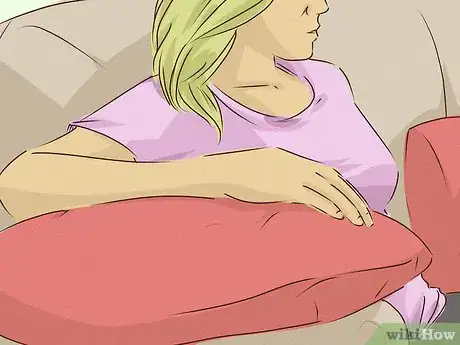
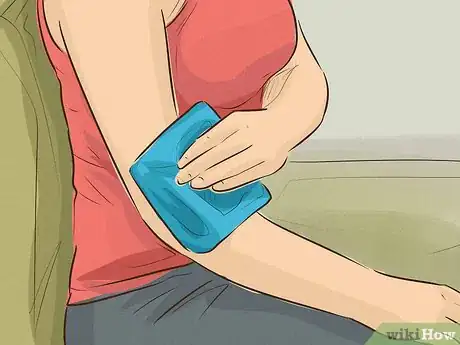
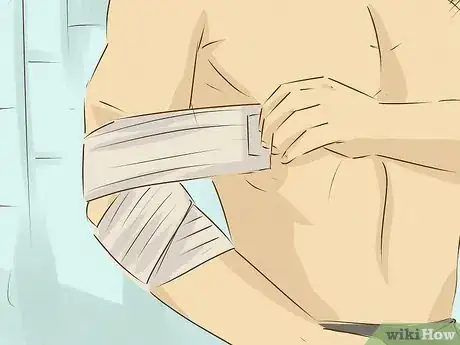

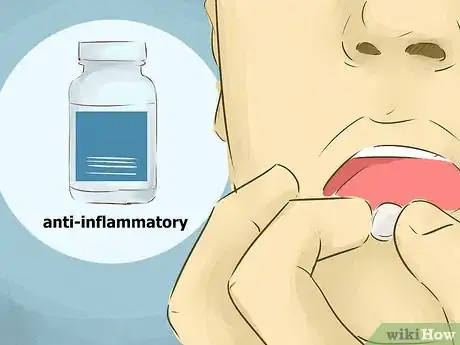
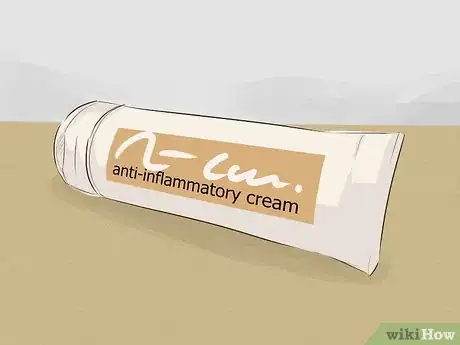
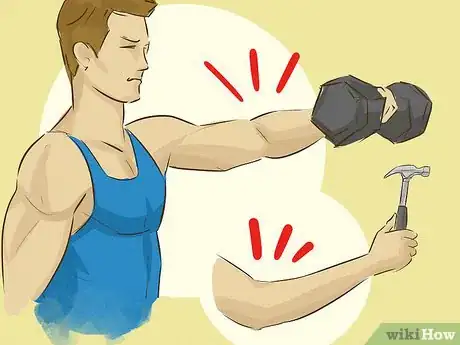
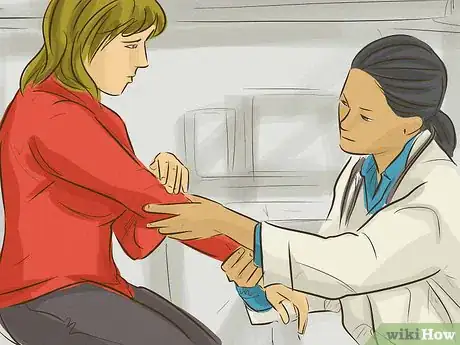
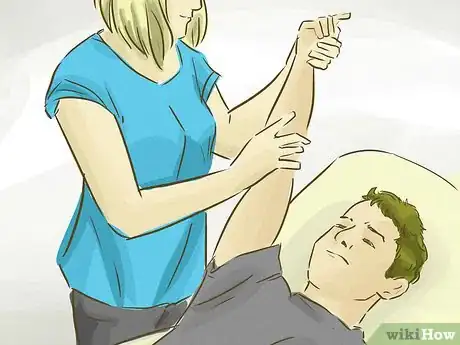
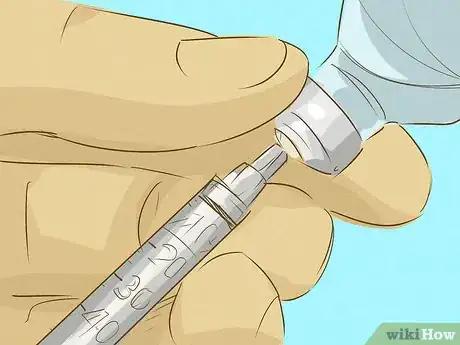
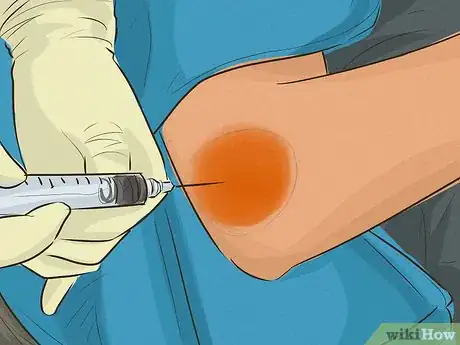
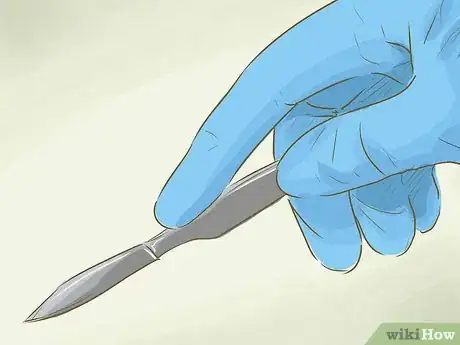

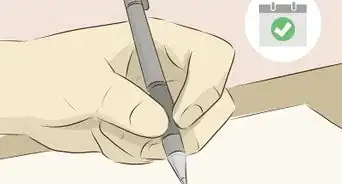
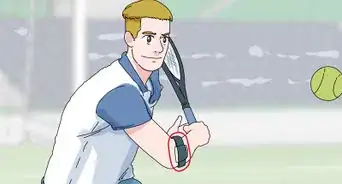
-Step-15-Version-3.webp)
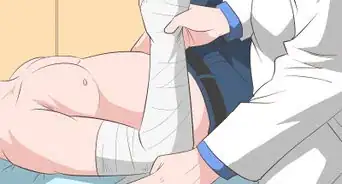
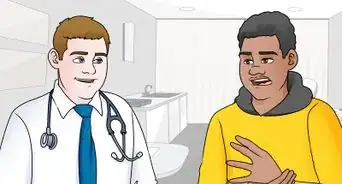
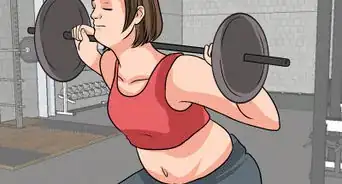
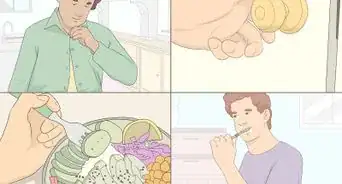
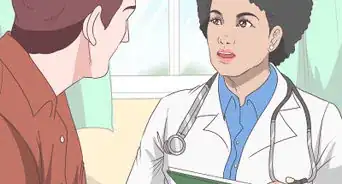

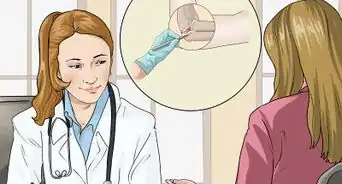
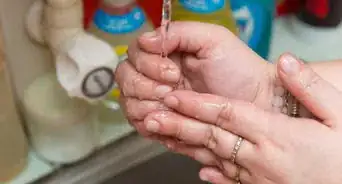

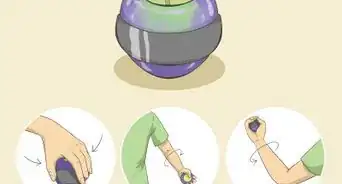






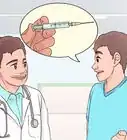
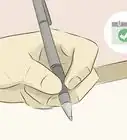

-Step-15-Version-3.webp)



































Medical Disclaimer
The content of this article is not intended to be a substitute for professional medical advice, examination, diagnosis, or treatment. You should always contact your doctor or other qualified healthcare professional before starting, changing, or stopping any kind of health treatment.
Read More...